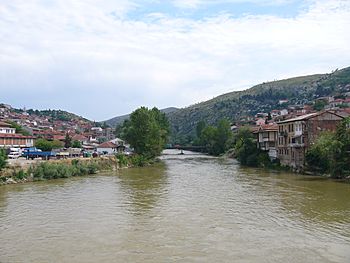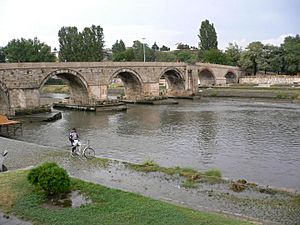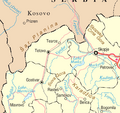Vardar facts for kids
Quick facts for kids Vardar |
|
|---|---|

Vardar in Veles
|
|
| Other name(s) | Вардар |
| Countries | North Macedonia and Greece |
| Physical characteristics | |
| Main source | Vrutok, near Gostivar |
| River mouth | Aegean Sea, near Thessaloniki 40°30′27″N 22°43′3″E / 40.50750°N 22.71750°E |
| Length | 388 km (241 mi) |
The Vardar River, also known as the Axios River, is a very important waterway in Southeast Europe. It is the longest river in North Macedonia and also flows through Greece. The Vardar River eventually flows into the Aegean Sea near the city of Thessaloniki.
This river is about 388 km (241 mi) long. About 76 km (47 mi) of its length is in Greece. The Vardar River collects water from a large area, covering about 25,000 km2 (9,653 sq mi). At its deepest, the river can be up to 4 m (13 ft) deep.
Contents
What's in a Name? The Vardar River's History
The name Vardar for this river might come from an ancient language called Thracian. Other old languages like Paeonian and Ancient Macedonian were also spoken in the areas where the river flows.
Many people think Vardar comes from an older word, Vardários. This word might mean "black water" in a very old language called Proto-Indo-European. The name Axios might also be from Thracian and could mean "not-shining" or "dark."
Ancient Greeks sometimes used the name Vardários around 300 BC. This name was also very common during the Byzantine Empire. The famous Greek poet Homer mentioned the river as Axios in his epic poem, the Iliad. He wrote that it was the home of the Paeonians, who were allies of Troy.
Where Does the Vardar River Flow?

The Vardar River starts high up at a place called Vrutok, which is a few kilometers southwest of Gostivar in North Macedonia. From there, it flows through several cities.
- It passes through Gostivar.
- It flows through Skopje, the capital city of North Macedonia.
- It continues to Veles.
After flowing through these cities, the river crosses the border into Greece near Gevgelija. In Greece, it flows past towns like Polykastro and Axioupoli. Finally, it empties into the Aegean Sea in northern Greece, west of Thessaloniki.
The area that the Vardar River drains, called its basin, covers about two-thirds of North Macedonia. The valley around the river has very rich and fertile land, especially in the Polog region and near Gevgelija and Thessaloniki. In other places, mountains surround the river. Major highways in Greece (Greek National Road 1) and North Macedonia (M1 and E75) follow the river valley for most of its length.
The Vardar River was very well-known during the time of the Ottoman Empire. Even today, it inspires many folk songs in modern Turkey, with "Vardar Ovasi" being one of the most famous. The river is also shown on the coat of arms of Skopje, which is also on the city's flag.
Connecting Rivers: The Danube-Vardar-Aegean Canal Idea
For a long time, people have dreamed about building a canal that would connect the Morava River valley with the Vardar River. This would create a waterway linking the Danube River to the Aegean Sea.
In 2017, there was a big proposal from Greece and Serbia to build this huge canal project. It would be about 651 kilometers long and cost a lot of money, around 17 billion. This project aims to make it easier for ships to travel between Central Europe and the Aegean Sea.
The Vardaris Wind
The Vardaris or Vardarec is a strong, cold wind that blows through the Vardar River valley. This wind is common in both Greece and North Macedonia.
- It usually starts as a gentle breeze, moving down the Vardar valley.
- When it reaches the tall mountains between Greece and North Macedonia, it picks up a lot of speed as it rushes down the other side.
- This powerful wind brings cold weather to the city of Thessaloniki and the area around the Axios delta.
The Vardaris wind is a bit like the mistral wind in France. It happens when the air pressure over Eastern Europe is higher than over the Aegean Sea. This is often the case during winter.
Gallery
-
Vardar (Axios) river in Greece
See also
- Great Morava
- Pčinja River








